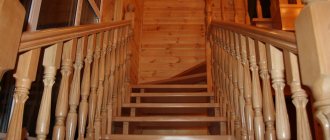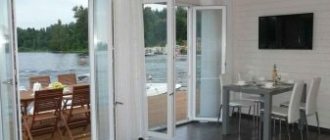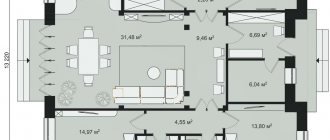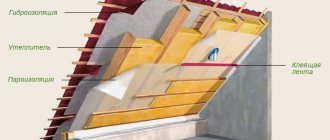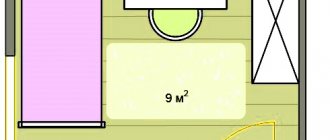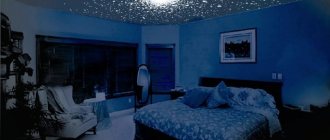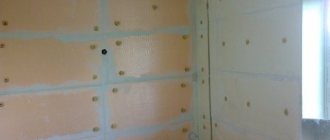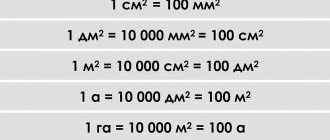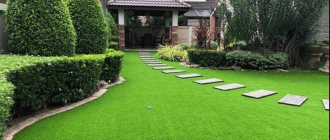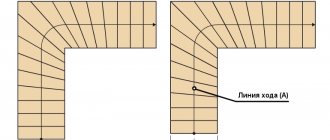03/21/2016 master
Creating favorable conditions in the house for normal rest requires taking into account all possible parameters and nuances. Particular attention must be paid to the level of illumination. After all, the general health of a person, his emotional and psychological comfort depend on this parameter.
Therefore, it is very important to calculate how many lumens of lighting are needed per square meter? You will learn about this and what level of illumination you need to create in our article.
Important parameter
Illumination is a very important indicator, without which a comfortable stay in any room of the house is impossible. Each room in the house has its own lighting standards. Therefore, various kinds of calculations that relate to this norm are a necessity. In this situation, you need to make the following calculations:
- number of lamps per square meter;
- number of lighting fixtures per square meter;
- how many lumens are needed to illuminate a room per square meter.
In this article we will focus on the last calculation.
What you should know
When determining how many light bulbs or lighting fixtures are needed, the first step is always to calculate the number of lumens per square meter for a particular room. In this case, you need to know what lighting levels are set for each specific residential or non-residential premises. All these standards are given in special documentation - SNiP.
Standards according to SNiP
You can create the desired level of illumination using various light sources:
- incandescent lamps;
- fluorescent and LED light bulbs;
- halogen and metal halide lamps;
- LED strips;
- neon lamps, etc.
Each of the above light sources has different technical illumination indicators. The most important parameter when assessing the lighting level is the luminous flux emitted by the light source. The power values of lighting devices indicated in the table are given for incandescent lamps, since these basic regulatory documents were developed even before the era of the advent of modern energy-saving technologies. Today, ordinary incandescent lamps are practically no longer found in the home. They have been replaced by LED, fluorescent and halogen light sources. At the same time, LED light bulbs are the most popular, since they are very economical in terms of energy consumption, have better technical performance and a longer service life than other energy-saving light sources. Luminous flux is measured in lumens. The luminous flux value can be found on the packaging of the light bulbs. At the same time, asking the question of how many lumens are needed to illuminate one square meter is not always correct. This is due to the fact that the luminous flux in this case reflects only the specific capabilities of a particular light source. In this case, the distance from the selected lighting object for the room is not taken into account. Therefore, it is rational to introduce such a parameter as lighting. It is measured in lux.
Based on this, equality was established between lux and lumens. Thus, per one meter of square room area there is a luminous flux of one lumen and it is equal to one lux. This standard applies to all premises, both residential and non-residential.
Note! As you move away from the light source, there is a proportional decrease in illumination per square of the distance.
Residential illumination standard: W per m2
Experts have developed special light standards for living rooms (W/m²), which are shown in the document SNiP 05/23/95. It is called “Natural and artificial lighting”.
Standards for SNiP (SP) and SanPiN
They contain recommendations for residential premises, as well as for offices, schools, kindergartens, hospitals, boiler rooms and other premises. These standards apply in Russia, Ukraine, and many European countries.
Required volumes
After we have understood the concept of illumination and equated lumens and lux, we can begin to determine the standard of illumination for the average person. Doctors and psychologists worked on this issue and developed the necessary indicators of the level of illumination for each room and room in the house. All of them are given in the SNiP table.
Note! All standards given in this documentation are recommended. In addition, they are minimal and for residential premises may undergo certain changes within the established range. At the same time, changes should be minimal so as not to negatively affect the human body. This range is 10-50 lux.
Indicators for the apartment
Existing standards allow you to create a comfortable level of lighting. They are given in lux, which can also be specified in lumens if desired. To calculate the number of lumens, you must use approximate methods. Using the parameters indicated in the table, you can approximately estimate the number of lumens that are needed to illuminate one square meter of a room with a ceiling height of approximately three meters.
How many lumens should the flashlight produce?
So, you have decided to purchase a flashlight and are thinking about what characteristics it should have. It is most logical to assume that the brightness of the light is the main parameter by which one can judge whether a device is good or not. But not everything is so simple. Today, real flashlights, and not their pathetic imitation, must have decent electronics, fittings, protection from external influences, for example, from water and dust, be resistant to shock, and also have a number of useful qualities. As we understand, these qualities cannot be embodied in one model so that its cost would be at the level of a toy. Of course, the price of the flashlight also plays a role. You can dig for a long time, arguing about what should be in a good lantern. But for now we will concentrate on the issue of the number of lumens.
Calculations for different lamps
The choice of light source directly determines the calculation of the number of lumens required to illuminate one square meter of space, depending on what standards exist for a particular room. Determining the type and number of light sources is the most important task for any apartment owner. To assess the required level of illumination and other indicators (type of light bulbs and their number), you need to evaluate the following parameters:
- room area;
- power of purchased light bulbs;
- SNiP standards.
Types of lamps
In a situation where you have purchased energy-saving light sources (fluorescent, LED, etc.), when calculating per square meter of room area, you must take into account the corresponding coefficients. For fluorescent light bulbs, the number of watts per square meter should be reduced by approximately 3.5-4.5 times. But if LED lamps are used - immediately 6-8 times. This situation has arisen due to the fact that modern energy-saving light bulbs have much greater light output compared to incandescent bulbs. As a result, with significantly lower energy consumption, such products will produce much brighter light. Therefore, their number will need to be reduced in proportion to the increase in light output.
Power table
In addition, it must be remembered that in this situation it is also necessary to evaluate the height of the ceilings. Today people live both in new buildings and in old Khrushchev buildings. And ceiling heights vary. If there are ceilings of three meters, the number of watts and lumens will need to be increased by at least 1.5.
Types of lighting
Modern technologies make it possible to install not only central lighting in rooms, but also additional lighting. This approach allows you to control the luminous flux by setting the desired lighting power. The following types of lighting are distinguished:
- directional - main sources - chandeliers, floor lamps, lamps;
- diffused – additional light sources mounted on ceilings and walls.
LED lamps in the apartment
The combination of these two types of lighting in rooms allows you to create ideal indoor conditions for work and relaxation.
Impact of the wrong light
Light is a necessary condition for a comfortable human life. Sanitary doctors have calculated standards and criteria for residential premises that have a beneficial effect on human health and mental state.
Recommended standards for the desktop
In apartments, windows are provided for natural light, but at night it is necessary to turn on artificial lighting. Lack of light in living rooms can lead to the following deviations:
- irritability and fear;
- headache;
- decreased performance;
- fatigue;
- insomnia;
- fatigue and redness of the eyes;
- exacerbation of chronic diseases.
Dim light in the room
Children suffer the most from lack of lighting in living rooms. If they have to do homework, read or play, or use gadgets in poor lighting, they may develop visual impairment.
Over the years, this problem will only get worse. Therefore, in a child’s room it is important to consider multi-level lighting of the room in order to illuminate the room, work and play area.
Important points
To make a professional calculation of the illumination level and the number of required lumens, the following points must be taken into account:
- lamp type;
- the height at which the lighting fixture will be placed;
- lamp type;
- its location in the room relative to the vertical plane. Here the efficiency of the lighting device should be assessed;
- reflective characteristics of the material used for interior decoration of the room: walls, floor and ceiling.
When determining the reflective capacity of walls, ceilings and floors, it is necessary to remember that the brighter the room is, the higher the amount of light reflection will become:
- if the ceiling and walls are made in light colors, then the light reflectance coefficient will be approximately 0.7;
- when decorating a room with light, beige and light gray facade paints, this coefficient will be approximately 0.5-0.6;
- for dark colors – 0.3;
- when decorating a room with black granite or marble, the reflection coefficient will be approximately 0.1.
To calculate the optical characteristics of a room, use the efficiency parameter and special unified tables.
Note! If you do not have the desire or ability to independently produce lumens to determine the level of illumination, you can use the services of specialized offices.
They will be able to quickly make the necessary calculations, eliminating possible errors or errors.
Are there any errors in the calculations?
Since we have already made allowances for the features of each individual lamp, it is fair to clarify that there will be errors in the calculations. The most accurate indicators of the required illumination can be obtained using a special device - a lux meter.
But the tables we provide allow us to achieve a minimum level of error - it will definitely not affect either comfort or health. If it is not possible to use professional calculations, you can calculate everything yourself and choose the optimal solution.
64945
Date of publication: 05/03/2018
We carry out calculations
To determine the illumination for a surface (in lux), as well as the luminous flux indicator (in lumens), several calculation steps should be performed:
- calculation of the total value of luminous flux required in a specific room;
- then, based on the obtained figures, you need to determine the required number of light sources depending on their power.
In order to determine the luminous flux indicator (in lumens), you should use a special formula - “luminous flux = X * Y * Z”, where:
- X is the norm established for the illumination of a specific room/object. To do this, follow the SNiP table given in our article very first;
- Y – area of a specific room (indicated in square meters);
- Z is a correction factor that is entered depending on the height of the ceilings in the room for which calculations are being made. If the ceiling height is from 2.5 to 2.7 meters, then the coefficient is taken as equal to one. If there are ceilings from 2.7 to 3 meters, coefficient = 1.2. If you are the happy owner of ceilings from 3 to 3.5 meters, then the coefficient = 1.5. Rarely, but ceilings can be from 3.5 to 4.5 meters. In such a situation, the coefficient will be equal to 2.
Ceiling height is important
Substituting all the values into the formula, you will get the number of lumens that are needed per square meter of a particular room. After this, you need to complete the calculations by determining the number of light bulbs and fixtures that should be installed in the room in order to obtain a high-quality and comfortable level of illumination. To do this, you need to be guided by the table, which shows the luminous flux power indicators for an LED lamp. We settled on an LED light source, since this is what is most often used today for indoor lighting.
Luminous flux power indicator table
The value that we obtained at the first stage must be divided by the luminous flux of the light bulb used (taken from the table) and you will receive the required number of LED lamps of this power for the room.
Warm or cold
Natural daylight has a warm spectrum. It is comfortable for the eyes and body. But manufacturers produce lamps with a cold and warm spectrum, which have their own effect on the body.
Natural and LED lighting
Let's note the most important points:
- According to the standards, cold glow is recommended for work areas. It increases concentration and tones the body.
- A warm glow is installed in the relaxation areas. According to the norms, it helps to relax and calm down.
- Neutral light is the best option for a children's room and for any other room.
Comparative characteristics
It is important to take into account that the yellow and blue spectrum distort color perception, unlike natural light.
On the packaging, the light temperature is indicated in Kelvin (K). The yellow (warm) spectrum ranges from 2700–3500 K. The blue (cool) spectrum ranges from 5000–5400 K. Average values refer to natural (neutral) light.
Good to know
If you receive a non-integer value (for example, 3.75), it must be rounded up. A slight excess of the norm will be better than its deficiency. Better lighting will be achieved when lighting fixtures are evenly placed around the entire perimeter of the ceiling. In such a situation, as well as with some special design approach to lighting fixtures, you can take a larger number of light bulbs, but with less power. For example, instead of 4 lamps of 10 W, you can take 9 lamps of 5 W. As you can see, the calculations themselves are quite simple, but in order to carry them out you need to understand the nature of illumination and what influences it. By calculating everything correctly, you can create a comfortable level of illumination in any room of the house.
